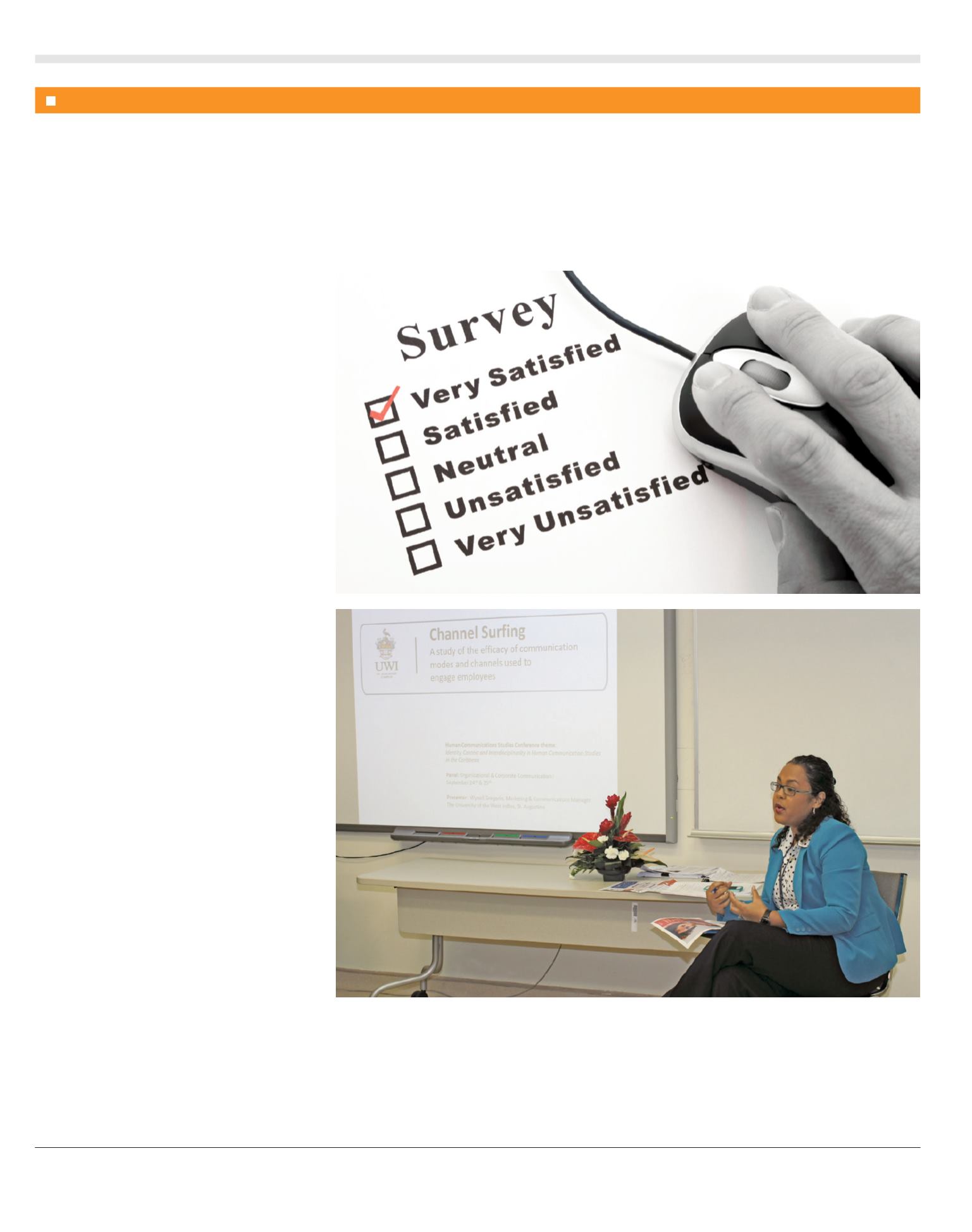
SUNDAY 1ST NOVEMBER, 2015 – UWI TODAY
11
HUMAN COMMUNICATION STUDIES CONFERENCE REPORT
A LinkedIn group invitation
pops up to discuss “5
ways Internal Communication matters,” a blog post
sends a prompt about the “All things IC” to my inbox
and the Ragan Summit on Employee Communications
is a reminder on my RSS feed. There is a deafening buzz
about internal communications on the Marketing and
Communications (M&C) landscape and its essential role
in organizational effectiveness, employee engagement and
Communications management. Undoubtedly, there is great
demand for discussion and analysis in the area; the reality
however, as David Cowan says in his book on Strategic
Internal Communications (2014), “If communications is
regarded as the organization’s Cinderella, then the Internal
communications unit is the department’s Cinderella.” He
suggests that while Internal Communications (IC) is not yet
as sexy as Social Media and Search Engine Optimization, it
is a maturing function. Organizations and communicators
continue to grapple for resources, as well as establishing
priority and measuring value.
The broad-brush approach to IC of sending an
email to all staff and ticking the box for good internal
communications is the norm among organizations. Here’s
the thing about using emails to reach your audience: they’re
quick, easy and with one click you have the ability to target
as many as you like. You’ll snag some in the process, but will
the message be opened and more so read, and understood?
Will it cause the intended action?
This was one of the harsh realities that prompted
the UWI study on its internal communications channels
undertaken by the M&C Office earlier this year. With over
74 trillion emails per day being sent globally, it’s no secret
that we suffer from information overload and message
saturation. So how then do you ensure that that your
messages are being heard? Add to that, the well-quoted
global stat that “70 % of employees are not engaged,” the
Campus’ strategic focus on employee engagement; the
need to put people first, as well as building a culture of
engagement with IC at its core – it was clear we needed to
do the research and establish a baseline before we could do
anything that would encourage our community to check
every ‘very satisfied’ box.
Our study aimed at gauging the success of the existing
communication methods to help us identify the best
way to communicate with staff – and in essence, learn
their preferences when it comes to volume and type of
information.
This communications audit gleaned robust data in the
areas of channel preference, timing, content and layout by
the various employee groupings our findings were quite
instructive for future IC planning.
Mirroring global data, our Campus study found that
the top three channels for IC included emails, intranet
and the website. Staff members articulated a sense of
being well informed of campus happenings due, in large
part, to daily and weekly emails from the Marketing and
Communications Office.
Emails sent are well received. Staff members were
largely satisfied with the content and layout of the email
bulletins but also looked to their managers, staff meeting
andword of mouth for information. Information on training
and development opportunities for staff and events were
of particular interest to all staff with this factor arising in
different categories of the survey.
For future improvements, there was a call for greater use
of technology, including mobile apps, feedback loops, more
information of University issues and layout enhancement
to current communication channels.
Overall, nine in 10 staff members, in all categories,
shared the view that they were well informed as a result of
internal campus communication, and while the satisfaction
levels are high, our aim is to do further exploration. A deep
dive into the ‘whys’ and ‘hows’ that comes with a mixed
method approach is the next step to ensuring that we can
Are you happywith the
conversation at work?
B Y W Y N E L L G R E G O R I O
Wynell Gregorio’s presentation at the 2nd Biennial Human Communication Studies International Conference was
“Channel Surfing – A study of the efficacy of communication modes and channels used to engage employees.”
and responding to our audiences.
The findings of the study prompted a series of
further research exercises involving other audiences –
communication surveys that targeted current students and
prospective ones – enabling us to develop more holistic
insights into the campus community’s preferences.
draw conclusions and set direction for IC strategy at the
St. Augustine Campus. This user-driven approach to IC
planning will allow us to understand our employees, their
nuances, their preferences and tailor ourmessages to have an
impact. As Communicators, our role as content creators and
content curators, demands that we are constantly listening
Wynell Gregorio presenting on the value of internal communications.
Overall, nine in 10 staff members,
in all categories, shared the view
that they were well informed
as a result of internal campus
communication, and while the
satisfaction levels are high, our
aim is to do further exploration.


